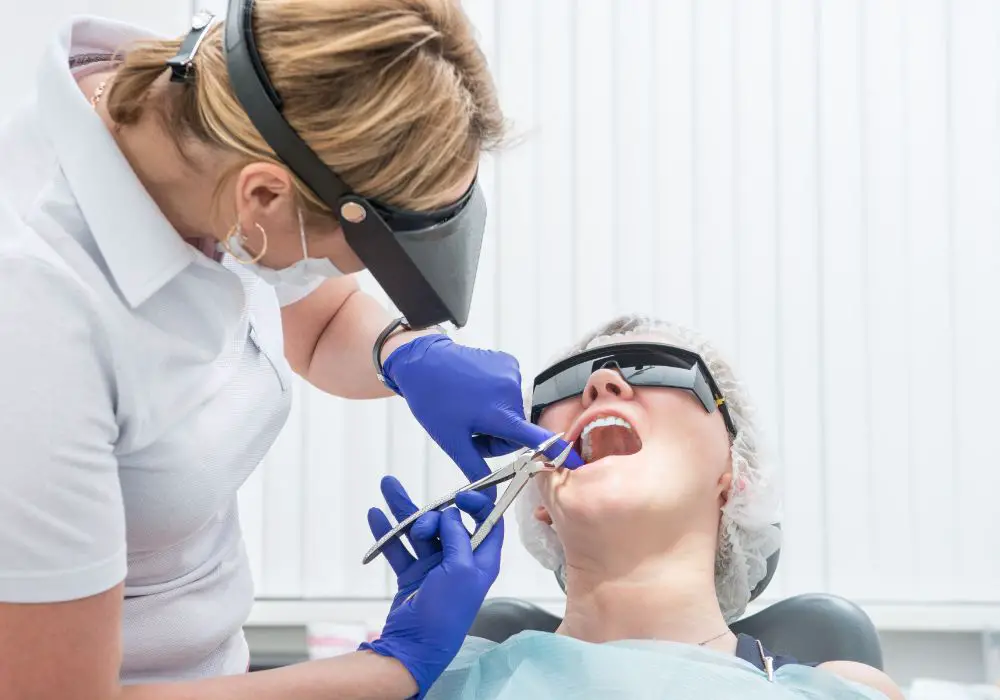Did you know around 85% of people have their wisdom teeth extracted?
While it’s not necessary, your dentist might recommend this procedure for a number of reasons.
For instance, maybe your mouth is too small to accommodate third molars. Or the wisdom teeth are growing at an angle to other teeth, causing you mild discomfort.
In some people, wisdom teeth can cause several issues, including jaw damage, sinus pains, and inflamed gums. Hence, the need to remove them.
With that in mind, it’s normal to feel pain and soreness after having your third molars removed. For this reason, your dentist might recommend soft foods to prevent irritation of the wound and accelerate the healing process.
But what are these soft foods? Well, that’s where we come in.
Here, we will explore several foods and liquids to consume after wisdom tooth removal, plus those you should avoid.
Foods To Eat on The First Day After Teeth Removal
During the first 24 hours after wisdom tooth extraction, a blood clot will form inside the empty socket. This clot helps to protect the underlying connective tissues, nerves, and jawbone as the wound heals.
So, you need to avoid foods that might dislodge or dissolve the blood clot. Failure to do so might lead to a dry socket (alveolar osteitis), a condition that causes throbbing pain. If that’s not scary enough, the wrong foods might irritate the extraction site, causing bleeding.
Below, we’ve highlighted a few foods that might help you avoid these problems. Let’s check them out.
1. Greek Yogurt
Besides its creamy and smooth texture, Greek yogurt is nutritious and perfect for consumption after oral surgery. This yogurt contains vitamins and minerals such as zinc and calcium, which are crucial for your recovery.
2. Soup and Broths
You can also consume blended soups, like pumpkin or tomato soups, during the first 24 to 48 hours after surgery. These soups will keep you hydrated while providing you with essential vitamins, minerals, and other nutrients.
But avoid taking hot soups because they might irritate the surgical site, inducing bleeding or swelling. Also, ensure the soups are free from solid pieces that might get into the empty tooth socket and dislodge the blood clot.
Besides soups, you can try bone broths, as they are rich in minerals like calcium and phosphorous. On top of that, soups are packed with amino acids and have anti-inflammatory properties.
3. Smoothies
Smoothies are healthy, easy to eat, and contain the essential nutrients required in your healing journey.
You can prepare a smoothie using bananas, carrots, cucumbers, or mangoes and add protein powder to enhance its nutritional value. However, avoid fruits with seeds, such as strawberries, because they might enter the tooth socket, causing an infection.
4. Ice cream
After 24 hours of tooth removal, you can treat yourself to ice cream. This food requires less effort to consume and offers a cool effect that will soothe your inflamed tissue and enhance a quick healing process.
But we recommend you opt for fruit-based ice creams, like banana ice cream because they contain less sugar and fat.
5. Applesauce
Applesauce has a smooth texture that requires little jaw movement, making it a great food to eat after removing wisdom teeth. In addition, the sauce contains high levels of dietary fiber and Vitamin C, which boost the immune system.
Foods you Can Eat Three Days after Teeth Removal

After the third day, the pain and swelling at the extraction site will begin to reduce. That means you can introduce semi-soft foods into your diet, including:
6. Mashed Potatoes
Do you love mashed potatoes? You’re in luck because this food can help you in your recovery journey. Mashed potatoes contain high amounts of carbohydrates, which provide you with energy.
This food is also rich in nutrients essential for healing and keeping the immune system strong.
But before consuming the food, ensure it’s smooth and free from chunks that can cause unexpected irritations. To loosen the mashed potatoes even further, add butter, gravy, or milk.
You can also try out mashed bananas and mashed pumpkin, which can provide you with a variety of minerals and vitamins, such as:
- Folate
- Vitamin A, B6, C and E
- Potassium
- Manganese
7. Scrambled Eggs
Scrambled eggs are great for anyone recovering from tooth extraction surgery. They are highly nutritious, providing you with Vitamin A and B12, iron, selenium, and iron. These minerals and vitamins help your body maintain a healthy immune system and heal wounds.
8. Oatmeal
Since oatmeal is sticky and chewy, it’s not the ideal food during the first 24 hours of wisdom tooth removal. But after three days, you can consume this nutrient-rich food.
And the best part? Instant oatmeal can keep you full for longer hours. It also contains minerals and vitamins vital for healing.
But ensure the oatmeal cools down before eating it to avoid unnecessary pain and discomfort.
9. Salmon
Another food worth mentioning is salmon. This fatty fish is considered the most nutritious food on earth. It is easy to eat and comes loaded with key nutrients, such as:
- Selenium
- Vitamin B6 and B12
- Phosphorous
- Niacin
It is also an excellent source of healthy fats, like omega–3 fatty acids, which might help in reducing inflammation and wound healing.
What Foods to Avoid After Wisdom Teeth Extraction?
After wisdom teeth extraction, expect your dentist to caution you against several foods that might irritate the wound. These could include:
- Grain and seeds: Cereals, rice, or corn can easily get trapped in the healing site, causing immeasurable pain. So, avoid these foods until your wound heals fully.
- Hard-to-chew foods: Within the first week of tooth removal, avoid hard-to-chew foods. Otherwise, you might re-open the stitches on the extraction site, delaying recovery.
- Crunchy foods: Avoid your favorite crunchy and crumbly foods like popcorn, cookies, and chips. If these snacks get trapped in the socket, they can cause an infection and other issues.
- Alcohol and carbonated drinks: Carbonated drinks and alcohol can irritate the surgical site. They can also interact with prescribed medications, affecting their ability to reduce pain and inflammation. But that’s not all: Alcohol hinders your body’s ability to heal wounds, fight infection and reduce inflammations. So, stay away from this substance for at least 7 to 10 days after your surgery.
- Spicy foods: Avoid foods with hot spices like cayenne pepper, chili, funnel, and hot paprika. These foods can irritate the areas around the wound, causing discomfort and delaying healing. The same goes for highly acid fruits like citrus.
Note: Avoid using a straw to drink liquids when the wound has not fully recovered. The suction from the straw can displace the blood clot inside the socket, leading to alveolar osteitis.
What to Expect After Wisdom Teeth Extraction?

Now that you know what food to consume after tooth extraction, let’s discuss the healing process.
But keep in mind, people are different. While some might experience severe pain and discomfort after the surgery, others might only deal with minor discomfort.
On that note, here’s what to expect after removing your wisdom teeth.
First 24 Hours
In the first 24 hours after the surgery, slight bleeding may occur from the wound area. You may also feel some pain and swelling on the extraction site, as well as subtle effects of anesthesia.
As the bleeding stops, blood clots will form in the socket to protect the underlying bone. The doctor might place a gauze over the wound to aid in the healing process. He may also prescribe a few pain medications to help alleviate the pain and swelling.
By the end of the day, the pain and effect of the anesthesia would have reduced, allowing you to resume less strenuous activities.
However, if the pain or bleeding persists, consult your oral surgeon for medical advice to avoid the risk of further complications.
Days 1 and 2
The first two days after extraction are crucial since the wound is undergoing intense healing. As a result, you might notice some slight bleeding and soreness at the surgical site.
Day 3
By the third day, your wound should be healing well. While you might not notice any bleeding, the extraction site might still feel tender and sore. Fortunately, you will not feel any pain or discomfort.
Post 1 Week
The blood clot usually forms fully after one week of tooth extraction. If the dentist used dissolving stitches, they will dissolve by the end of the week too. At this point, you should not experience any bleeding or discomfort.
Post 2 Weeks
The empty socket heals completely by the end of the second week. However, the site might still feel sensitive and tender. But this is no cause for alarm.
In the second week, you can enjoy eating your favorite dishes worry-free. But avoid chewing excess food around the wound.
And when brushing, don’t brush the tissue around the extraction site to avoid injuring the socket and causing an infection.
By the end of the month, your wound will be fully healed. But it still helps to exercise caution when eating and cleaning your mouth.
Bottom Line
Finally, you have reached the end of our piece. As you can see, the foods you eat after wisdom teeth removal can influence how your wound heals.
If you eat crunchy, acidic, or spicy foods, the extraction site might get irritated or infected, delaying recovery. But if you eat soft and semi-soft foods, like mashed potatoes, scrambled eggs, or salmon, expect your wound to heal faster.
In light of this statement, remember this healing journey is unique to you. So, consult your dentist or oral health specialist for guidance when you encounter an issue.
Armed with this knowledge, we hope you will make the right food choices to promote faster recovery after wisdom teeth removal.
Best of luck!






